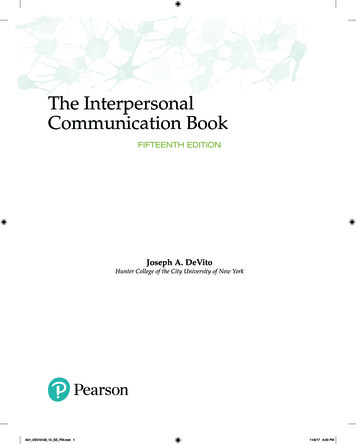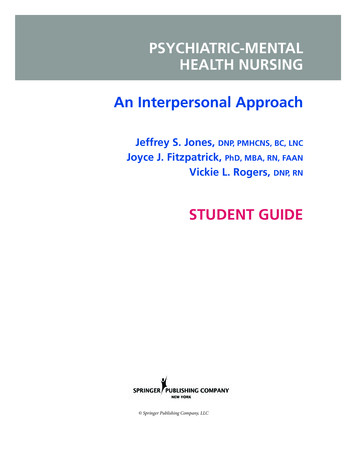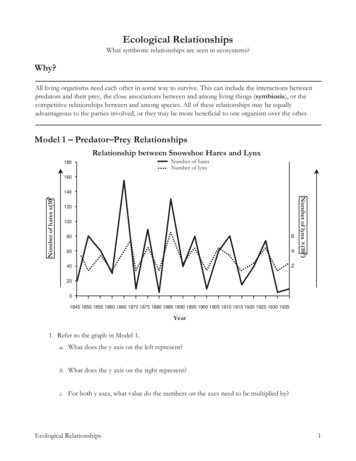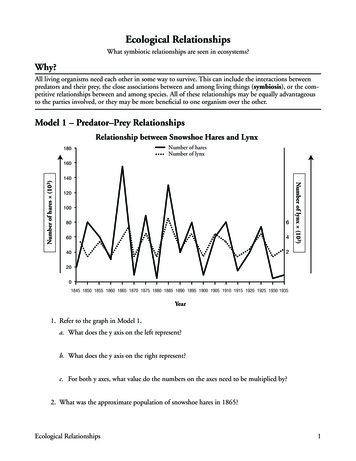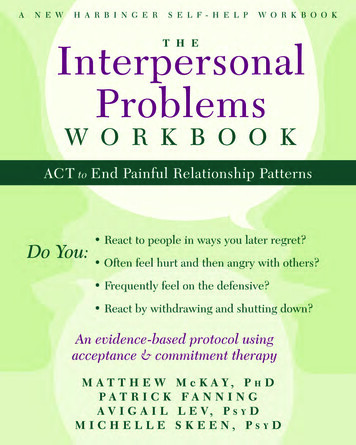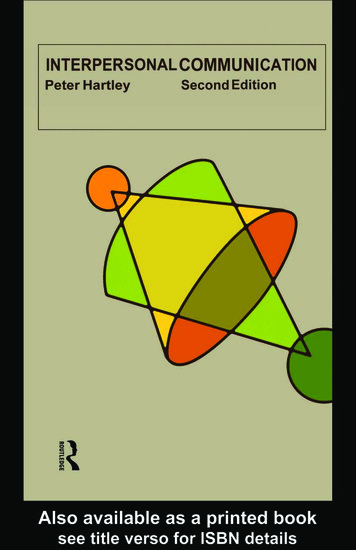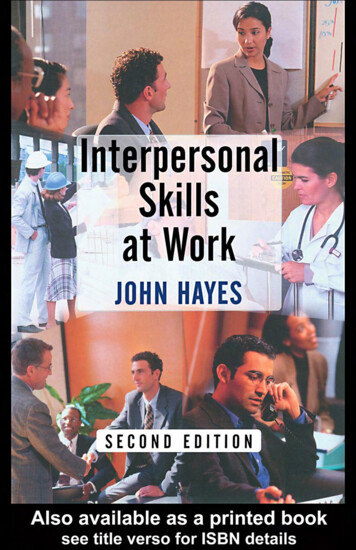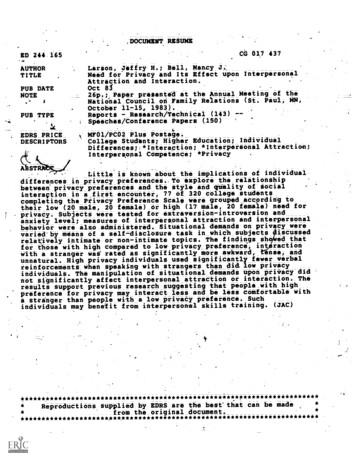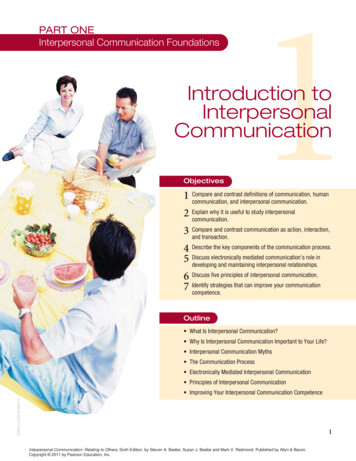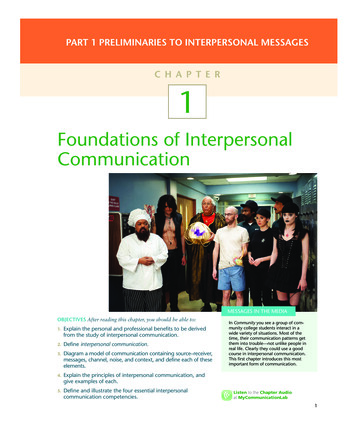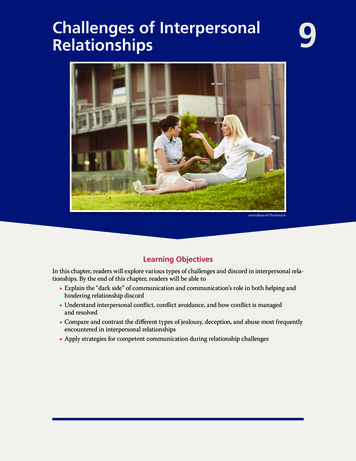
Transcription
Challenges of rning ObjectivesIn this chapter, readers will explore various types of challenges and discord in interpersonal relationships. By the end of this chapter, readers will be able to Explain the “dark side” of communication and communication’s role in both helping andhindering relationship discord Understand interpersonal conflict, conflict avoidance, and how conflict is managedand resolved Compare and contrast the different types of jealousy, deception, and abuse most frequentlyencountered in interpersonal relationships Apply strategies for competent communication during relationship challenges
The “Dark Side” of Interpersonal CommunicationChapter 9IntroductionSuppose that you have been assigned a class project that requires you to perform some complicated mathematical calculations and write a paper. You are confident of your ability to write thepaper; however, your math skills are poor. You ask your sister for help with the math problemsduring the coming week. In return, you offer to let her borrow your car for the week while hers isin the shop for repairs. Your sister agrees to the arrangement, and you give her your car keys thefollowing day. During the coming week, you ask her twice to help you with the math problems;each time she tells you that she is busy. Tomorrow is the deadline for the project to be submitted, and your sister says she does not have time today to help you with the math. The two of youbegin to argue, and you accuse her of taking advantage of you by using your car all week andnot helping you as she promised. You ask that she return your car keys immediately. Your sisterbecomes upset with you, claiming that her schedule is busy and you just kept asking for her helpat inconvenient times.Every relationship experiences difficulties, whether in the form of conflict, jealousy, deception,and even aggression or abuse, but how the relational partners work together and communicatein the face of these challenges is what will ultimately make or break their relationship. If thepartners can talk through the experience and understand each other’s perspective, they can likelymanage the challenge successfully and move on. However, if the partners ignore the issue or onlydeal with it by yelling and being angry at each other, it may be an issue that the relationship cannot overcome. No relationship is perfect, but if the good times outweigh the bad ones and bothpartners believe that the relationship is worth working on and maintaining, the partners canstrive to be satisfied, committed, intimate, and invested. Being able to understand and navigatecommon relationship difficulties is instrumental for the successful continuation of any close relationship, and it is thus the focus of this chapter.Chapter 9 explores challenges and discord that can arise in different types of interpersonal relationships. The discussions address the “dark side” of interpersonal communication, and howcommunication can both contribute to and assist in tackling the challenges that relational partners face. We discuss the specific challenges of conflict, jealousy, lying, and deception, as well asverbal and online abuse, and we conclude the chapter with suggested strategies for competentcommunication when challenges arise in relationships.9.1 The “Dark Side” of Interpersonal CommunicationThe phrase “dark side” was in large part popularized when the movie Star Wars, now Star WarsIV: A New Hope, was released in 1977. In this film Darth Vader tries to entice Luke Skywalker toreject the way of the good and instead join the “dark side.” Turning or going over to the dark sidemeans you have let your evil side take over, and in doing so you give up on the good or benevolent forces that may have previously guided you. The phrase now has an iconic role in Americanpopular culture, and it generally refers to an evil, malevolent component of something.The phrase “dark side” is also used in reference to how we behave in our interpersonal relationships. Interpersonal communication researchers William Cupach and Brian Spitzberg (1994)published a book called The Dark Side of Interpersonal Communication, in which they exclusively focused on the malevolent forces that can influence interactions and relationships. In thisvolume, they initially defined the dark side of interpersonal communication as interactions
The “Dark Side” of Interpersonal CommunicationChapter 9that are challenging, difficult, distressing, and problematic. Dark side messages also involve “dysfunctional, distorted, distressing, and destructive aspects of human action” (Spitzberg & Cupach,1998, p. xiv). Cupach and Spitzberg (1994) began to study the dark side of communication inorder to balance the scholarly understanding of how we positively relate to each other—throughself-disclosure and by showing love, cooperation, and empathy—with the negative, destructiveaspects of relationships. Such a balance between bright and dark allows for a more comprehensive consideration of how relationships—and the communication that sustains them—trulyfunction. Research on conflict, jealousy, deception, stalking, hurt, anger, infidelity, and verbaland physical abuse grew exponentially after Spitzberg and Cupach’s initial studies, and with thisresearch, our understanding of the dark side of communication developed as well.But before we delve into some of the mostcommon challenges that are faced by relational partners, it is important to point outthat no message is purely dark, just as nomessage is entirely bright. There can be negative aspects to qualities or messages thatwe generally view as positive. For example,as we explained in Chapter 7, being entirelyhonest and open with your partner couldhurt his or her feelings or expose you tovulnerability or violations of your privacy.In addition, relying on humor and jokes,especially ones that are sarcastic or pointed,can prevent your partner from truly knowing who you are. As we saw in Chapter 8,extending social support to another canbackfire and make things worse if the person in need does not view it as being helpfulor sees it as a form of oversupport.Hemera Technologies/AbleStock.com/Thinkstock Some “dark messages” are not wholly destructive and cansometimes be useful or valuable. Anger, if expressed in a manner that isn’t harmful, can help partners confront and workthrough relationship challenges.In the same way, “dark messages” do not always have to be entirely destructive and can sometimes be useful or valuable. Being jealous and expressing that jealousy is often viewed as a sign ofweakness, but it can also be a signal to your partner that you care about the person or find him orher appealing and attractive. A relationship in which interpersonal conflict is entirely absent mayseem calm and tranquil on the surface, but there are likely at least a few upsetting and troublesome issues beneath that surface that are not being addressed. Expressing anger, if done in a manner that does not hurt anyone psychologically or physically, can help both partners realize thatthe issue is an important one and that frustration has risen to a level that is no longer sustainable.Although communication can be dark, it can also be an essential way to confront relationshipdifficulties and challenges. The context, situation, and nature of the relationship between thepartners determine whether messages are viewed as helpful or harmful. But what is the impactof the dark side of interpersonal communication? In a comprehensive review of research on theimpact of good versus bad events on individuals, psychologist Roy Baumeister and his colleaguesdetermined that “bad is stronger than good” (Baumeister, Bratslavsky, Finkenauer, & Vohs, 2001,p. 323). Specifically, negative life events, interactions, and emotions are perceived and understoodmore clearly, are more easily recalled, and have more enduring, intense consequences for individuals than do positive ones (Baumeister et al., 2001).
Relationship ChallengesChapter 9Research has also shown, time and again, that the more often romantic couples grapple with darkissues such as conflict, jealousy, infidelity, and abuse, the lower their satisfaction with the relationship. In fact, engaging in negative marital interactions was a stronger predictor of relationship dissatisfaction than being positive toward each other (Gottman & Krokoff, 1989). Based onthis and other findings, psychologist and relationship researcher John Gottman (1994b) proposedthat the ratio of positive to negative interactions in a romantic relationship should be 5 to 1 forthat relationship to succeed. This 5 to 1 positive to negative message ratio is powerful evidence ofjust how important dark side messages can be in close relationships.9.2 Relationship ChallengesWhen you first form a relationship with another person, whether it is romantic or nonromantic, the relationship tends to be harmonious. When a relationship is in its infancy, both peopleare usually cautious about what they tell each other and how they say it, and they make a conscious and concerted effort to present positive information about themselves and to avoid conflict. Researchers have found that one of the reasons a new relationship is usually so pleasant andfriendly is that, at this stage, people emphasize the similarities they have and ignore their differences (Brown & Rogers, 1991).However, as a relationship progresses the differences between people emerge. When thesedifferences are small or judged to be insignificant by both parties, they can be easily ignored.Insignificant issues are still worth discussing. Having a partner who squeezes the toothpaste inthe middle of the tube, when you prefer that it be squeezed from the bottom, can be extremelyannoying. Leaving the milk out on the counter to sour instead of putting it back in the refrigerator can be financially wasteful as well as maddening to others. These minor issues can be bothersome, while other relationship challenges can be quite significant, such as engaging in infidelityor physical or psychological abuse. In fact, there are so many examples of negative communication behaviors that Cupach and Spitzberg, still the research leaders in this area of interpersonalcommunication, have edited five separate books devoted solely to dark side behaviors and messages in relationships. The following sections will focus on four of the most prevalent and frequently problematic relationship challenges that individuals typically encounter: (1) conflict andconflict avoidance, (2) jealousy, (3) deception, and (4) verbal and online abuse.Interpersonal Conflict and Conflict AvoidanceProbably the most frequent relationship challenges that you face are conflicts in your personaland professional life. The ability to identify and competently manage conflict will improve thequality of your relationships and make relationships more satisfying for you and your partner.Conflict goes beyond disagreements about how to accomplish a task or decisions between twoalternative courses of action. When conflict erupts, emotions are often involved, and the relationship can be threatened if the conflict is not managed or resolved amicably.The following definition, offered by conflict researchers William Wilmot and Joyce Hocker(2013), is used often and will help you recognize when you are dealing with a conflict. Wilmotand Hocker (2013) note that the following items must be present for a conflict to exist:1. There is an expressed struggle, meaning that one or both parties must communicate about theconflict in some verbal or nonverbal manner.
Relationship ChallengesChapter 92. There are at least two interdependent parties; the individuals involved need one another insome way, and their choices affect one another.3. The perception of these parties is that (a) they have incompatible goals, where they both wantdifferent things, or even want the same thing, such as a promotion, but cannot both have it; (b)they have scarce resources, such that there is not enough of something—money, time, or evenlove—to go around; and (c) they have interference from others in achieving their goals, wherethe presence of the other party is perceived to get in the way of how an individual wants to actor what that individual seeks to have.Let’s look at the separate components of this definition in relation to the situation presented atthe beginning of the chapter. This example exhibits all the components of Wilmot and Hocker’s(2013) definition of conflict. You and your sister Openly and directly communicate your feelings and frustrations to each other aboutthis conflict. Depend upon and need something from each other. Possess different goals, because you want your sister’s help in exchange for lending her yourcar, but she has been unwilling to assist you. There is not enough time or access to the car that can be divided up between you andyour sister. You each view the other as getting in the way of what you each ultimately want.Conflicts such as the one in this hypothetical situation can worsen over time, potentially even permanently damaging a relationship if they are not successfully managed or resolved. Interpersonalconflict can end marriages, separate friends, shatter families, and increase job dissatisfaction andturnover. It can also be painful and damaging to other people who are not directly involved in theconflict. If the conflict occurs in a family, for example, it can negatively affect children and otherfamily members and can impact relationships with one another as well as with the parties whoare involved in the conflict. In fact, children can also learn their parents’ conflict patterns and goon to use them in their own romantic relationships later in life (e.g., Koerner, 2014). Your abilityto competently manage and resolve conflict can thus help you face this relationship challenge andpreserve your important relationships.Conflict StylesOne of the most important things to understand about conflict is the communication style thatindividuals use. Management professor M. Afzalur Rahim (1983) identified five basic styles thatindividuals tend to use in their conflicts. These conflict styles are defined as patterned behavioral responses that individuals use across different conflicts and with different people. ThoughRahim originally developed this conflict style typology for the organizational context, it is nowalso widely used by scholars who are interested in conflicts in close relationships. These fivestyles can be understood by looking at the various combinations of two related dimensions:(1) how concerned you are about yourself and what you seek to get out of the conflict, and(2) how concerned you are about the other person and assisting the other in getting what heor she wants. See Figure 9.1 to understand how these two dimensions combine to create eachindividual style.
Relationship ChallengesChapter 9Figure 9.1: Conflict styles organized by dimensionEach of the five conflict styles considers the individual’s degree of concern for self versus hisor her degree of concern for the other person.High concern for omodationLow concern for othersHIgh concern for othersLow concern for selfSource: Adapted from Rahim, M. A. (1983). A measure of styles of handling interpersonal conflict. Academy of Management Journal, 26(2), 368–376.f09.01 COM200.aiThe first conflict style is avoidance, which occurs when there is a low concern for yourself anda low concern for the other party. When our style is to avoid conflict, we believe that if wejust ignore an issue, it will go away. If your sister prefers the avoidance style during the conflictexample we introduced at the beginning of the chapter, she would likely communicate by beingevasive, denying that the conflict exists, changing the topic, using humor to deflect the conflict,or physically or emotionally withdrawing from interacting with you. Withdrawal, by itself, is notalways negative; sometimes it is good to get away from the other person to get your emotionsunder control or to think about the issue before you discuss it. However, researchers found thatin failing marriages negative emotions overwhelm the interaction between the parties, who thenwithdraw from each other (Zautra, 2003). The goal should not be to always avoid conflict, but tostrategically use the avoidance style to manage conflict in a useful way.In the second style, accommodation, there is a low concern for yourself, but a high concern forthe other person. In other words, you are more interested in giving in to what the other partywants than you are about accomplishing your own goals. An accommodating person tends togive in to the demands of other people and accepts being “put upon” by others. If you used thisconflict style with your sister, you would communicate by tending to speak softly and often beingreluctant to express your opinion. You may also look down and avoid eye contact with your sister.Those with an accommodating conflict style have a body posture that is often closed, with theirarms drawn inward, and they rarely use gestures to punctuate their speech (Hartley, 1999).
Relationship ChallengesChapter 9The third style, competition, involves a high concern for yourself and a low concern for theother party in the conflict. A competitive style is evident when an individual engages in aggressive or competitive behavior by being critical, having a win-lose orientation, and engaging indirect confrontation. Imagine both you and your sister are competitive in your conflict. You maycommunicate using this style by speaking at a high or low pitch and having a demanding tone ofvoice. Your sister may be forceful or invasive in her communication and may try to intimidate you(Arredondo, 2000). For you and your sister, the goal is winning, and you each may interrupt, talkloudly, stare, or even be abusive in your communication. Those who use the competition conflictstyle also run the risk of inviting an even more aggressive response to their statements, which canresult in escalating disagreements and conflicts (Hartley, 1999).The fourth conflict style is compromise, in which there is a moderate concern both for yourselfand for the other person. Compromising in conflict involves some gains and some losses for bothparties. The individuals in the conflict work together to create a fair solution that is acceptable forboth of them, but that also means that no one gets entirely what he or she wants. After you andyour sister both cool down a bit, you might try to compromise by negotiating back and forth, suggesting trade-offs, and prioritizing what one wants the most versus what is more easily given up.This may mean that your sister drops everything to help you complete your assignment on timeand that you will not ask her to wash your car or refill it with gas. In formal conflict mediationsituations, many agreements are compromises—both parties formally agree to give up somethingin exchange for something else.When you have a high concern for yourself and a high concern for the other person, you willmost likely use the final style, collaboration. When using this style, an individual is attempting to create a win-win situation for both parties—one where both parties feel fully satisfiedand support the decision or solution that they have reached. As opposed to the compromisestrategy, where both parties have some gains and some losses, collaboration involves both parties achieving all that they originally sought and being satisfied with the outcome. Because bothparties must be satisfied in this conflict style, it is the most challenging and demanding stylethat you can use. To collaborate in our conflict example, you and your sister might make statements that disclose and describe your thoughts and feelings and seek similar information fromeach other. The collaborative individual will also be supportive about what the other party saysand may nonverbally communicate openness by nodding, making eye contact, facing the otherperson, and shifting his or her body posture so that it is open (for example, not sitting with yourarms crossed).Overall, these conflict styles are fairly enduring patterns that individuals tend to prefer usingin their conflicts. However, sometimes you might change your style. A particular person, topic,or situation could mean that you try out a different style. Specifically, because using these conflict styles involves two individuals interacting with each other, the other party in the conflictcan affect which conflict style you use. For example, if you usually prefer to talk things out inconflicts by compromising or collaborating, but your sister is always extremely competitive, youmay choose to instead use the avoidance style with her because her style preference offers littleopportunity to accomplish anything productive when you are in conflict with her. The Self-Testfeature will allow you to determine your preferred conflict style or styles.
Relationship ChallengesChapter 9S E L F -T E S TIdentify Your Conflict StylesThis self-assessment is designed to help you identify your preferred conflict management style.Read each of the statements below and circle the response that you believe best reflects your position regarding each statement. Then use the scoring key to calculate your results for each conflictmanagement style.When I have a conflict, I do thefollowing:Notat AllVeryMuch1. I give in to the wishes of the otherparty.123452. I try to realize a middle-of-the-roadsolution.123453. I push my own point of view.123454. I examine issues until I find a solutionthat really satisfies me and the otherparty.123455. I avoid confrontation about ourdifferences.123456. I concur with the other party.123457. I emphasize that we have to find acompromise solution.123458. I search for gains.123459. I stand for my own and others’ goalsand interests.1234510. I avoid differences of opinion asmuch as possible.1234511. I try to accommodate the otherparty.1234512. I insist we both give in a little.1234513. I fight for a good outcome for myself.1234514. I examine ideas from both sides tofind a mutually optimal solution.1234515. I try to make differences less severe.1234516. I adapt to the other party’s goals andinterests.1234517. I strive whenever possible towards50-50 compromise.12345(continued)
Relationship ChallengesChapter 9When I have a conflict, I do thefollowing:Notat AllVeryMuch18. I do everything to win.1234519. I work out a solution that serves myown as well as others’ interests asmuch as possible.1234520. I try to avoid a confrontation withthe other.12345ScoringWrite the number circled for each item on the appropriate line below (statement number is underthe line), and add up each ingCalculation Item 1Item 2Collaborating(problem solving)Item 4Item 7Item 12Item 8 Item 18 Item 14 Item 10 Item 17Item 13Item 9 Item 16 Item 5 Item 11 Item 3Avoiding Item 6 Competing(forcing)Your Score Item 19 Item 15 Item 20Source: Self-test from de Dreu, C. K. W., Evers, A., Beersma, B., Kluwer, E. S., & Nauta, A. (2001). A theory-based measure of conflict managementstrategies in the workplace. Journal of Organizational Behavior, 22, 645–668. Copyright 2001 John Wiley & Sons, Ltd.Consider Your ResultsThe higher your score, the more likely you are to use that particular conflict style. You might havescored highest on more than one style. If so, this means that you tend to use both styles when inconflict. Ask your close relationship partners to take this self-test and then compare your responses.Seeing how your conflict styles mesh with or are different from others can give you both insightsinto how you can more competently face the relationship challenge of conflict. Now consider thefollowing questions.1. Compare your conflict style with the conflict style of your closest friend or relationship partner.Do you tend to avoid conflict while the other person is more competitive? Are you, for example,an accommodator and the other person a compromiser?2. Now compare and contrast your role in these different relationships. Do you tend to use different conflict styles with your friend than you do with your relationship partner? What about witha coworker?3. Were you surprised by your dominant conflict style (or styles)? What information from this chapter could assist you in engaging in conflict more competently?
Relationship ChallengesChapter 9Management versus Resolution of ConflictWe often focus on what the outcome of a conflict will (or should) be, rather than on the process ofengaging in the conflict, from beginning to end. This focus on conflict outcomes also means thatwe emphasize the importance of conflict resolution. Three conditions must exist for a conflictto be resolved: The parties in the conflict decide to end the conflict. The parties are both satisfied with the outcome of the conflict. The parties do not engage in or deal with the conflict again.How many conflicts can you think of where all three of these conditions have been met? It isunlikely that you have many conflicts with others that have truly been resolved. Resolution isespecially hard to accomplish when the conflict is about an important or complicated issue, suchas where a couple will move, or when the issue is sensitive, such as when siblings are decidingwhere their elderly parents should live and who will take care of them if they fall ill. Althoughresolution is a worthy goal, it is often unrealistic in our experiences of conflict.Instead of resolution, most of our conflicts are dealt with via management. As we discussed interms of positive relationship behaviors, the conflict management outcome means that the partieshave dealt with the conflict for the time being, but one or both individuals remains dissatisfied.This means that there is a strong likelihood that the issue will come up again and that the partieswill engage in future interactions regarding the issue. Conflict management is a much more likelyoutcome if there is a specific conflict interaction. For example, Samuel Vuchinich (1990) foundthat 66% of family conflicts that occurred at the dinner table ended when the parties agreed todisagree, and 2% ended when one party left the table or refused to continue the conflict. In adifferent study, 79% of participants in a study of workplace conflict reported that their conflictsended without resolution (Gayle & Preiss, 1998). And in romantic relationships, the couples’ relationship satisfaction decreased as more conflicts went unresolved (Cramer, 2002).When an issue is managed rather than resolved, there is a much greater chance that it will reemerge later, and that the parties will have continued conflict about it. This is referred to as aserial argument, where a conflict about a particular topic or issue recurs over time and withoutresolution (Johnson & Roloff, 1998). Having a serial argument with a romantic partner can be astressful experience (Reznik, Roloff, & Miller, 2012) and can harm the relationship (Johnson &Roloff, 1998). Although management is the most likely conflict outcome, it can be problematicwhen conflicts become serial arguments. This may be why, compared to nonserial arguments,romantic partners in serial arguments were more likely to use collaborative communication andless likely to use avoidant or competitive communication (Bevan & Love, 2013). Serial arguersmay communicate more constructively because of conscious attempts to reach a resolution.Overall, conflict can be dangerous because it has a tendency to grow and worsen, particularlywhen it goes unresolved. But it is also important to remember that conflict can have importantbenefits that can strengthen a relationship and might even be desirable. For example, in theirstudies of marriage interaction, Patricia Noller and Judith Feeney (2002) reported that some conflict may actually be good for a marriage over time and can lead to the personal growth of bothparties—as long as negative communication is aimed at the other person’s specific behavior andnot at the whole person. For example, stating to your spouse “I’m upset because you did nottake out the trash” should not be threatening to the other person’s self-image, self-esteem, orto the relationship. In contrast, stating “Not taking out the trash is just one more indication ofyour general laziness” is likely to be harmful. The second statement is a form of criticism that
Relationship ChallengesChapter 9John Gottman, a prominent relationship researcher, cautions can be damaging to the relationship because it is a broad generalization that threatens your spouse’s self-esteem. (See EverydayCommunication Challenges to read more about Gottman’s research.) The first example is muchmore specific and less likely to indict the partner’s sense of self. Thus, although conflict is a common dark side of interpersonal communication, it is not entirely negative.E V E R Y D AY C O M M U N I C A T I O N C H A L L E N G E SGrappling with the Four Horsemen of the ApocalypsePsychology professor John Gottman is currently one of the most influential researchers in the studyof marital conflict. His studies, which involve long-term, in-depth observations of how spousesengage in conflict with each other, have spanned decades. From these data Gottman (1994a) created what he calls the Four Horsemen of the Apocalypse, which are four specific behaviors that,when spouses consistently use them in their conflicts with each other, are particularly damagingto the quality of their marriage. In fact, according to Gottman’s (1994a) findings, the more thatspouses use these messages in conflict, the more likely they are to get divorced. These four behaviors discussed in Gottman’s (1994a) research are Criticizing: Attacking your partner’s personality o
The “Dark Side” of Interpersonal Communication. Chapter 9. Introduction. Suppose that you have been assigned a class project that requires you to perform some compli-cated mathematical calculations and write a paper. You are confident of your ability to write the pa
